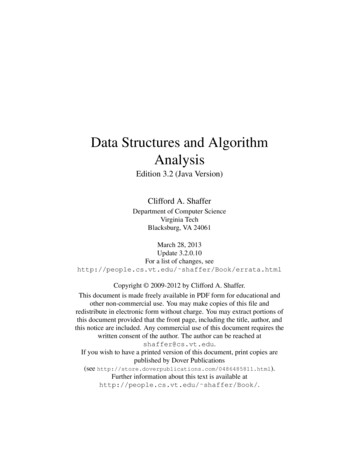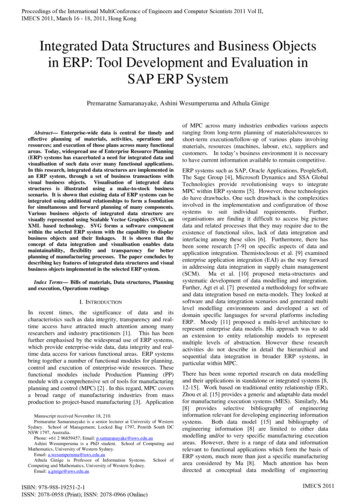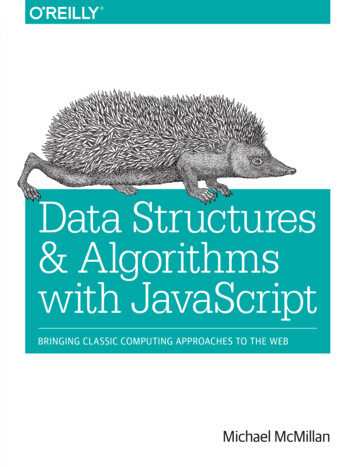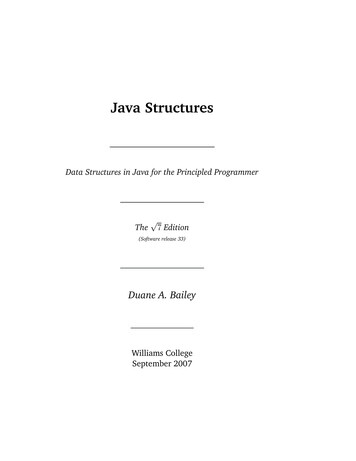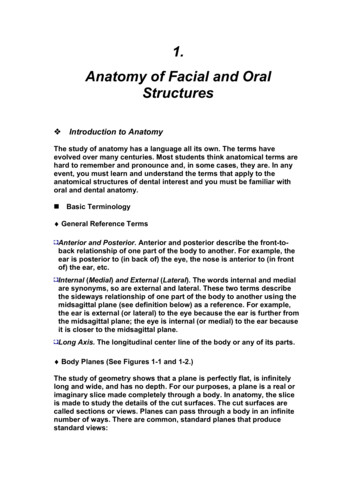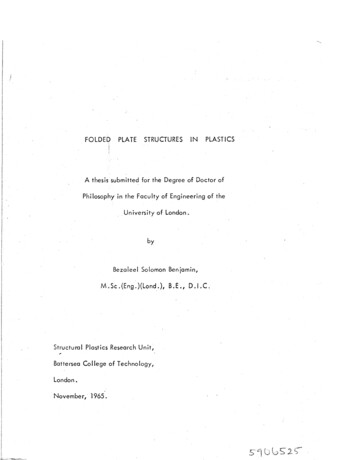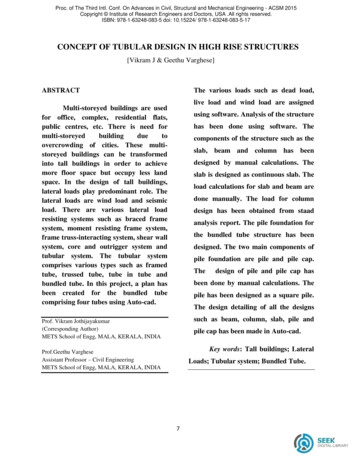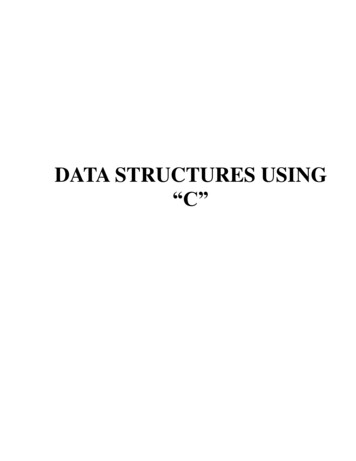
Transcription
DATA STRUCTURES USING“C”
DATA STRUCTURES USING“C”LECTURE NOTESPrepared byDr. Subasish MohapatraDepartment of Computer Science and ApplicationCollege of Engineering and Technology, BhubaneswarBiju Patnaik University of Technology, Odisha
SYLLABUSBE 2106DATA STRUCTURE(3-0-0)Module – IIntroduction to data structures: storage structure for arrays, sparse matrices, Stacks andQueues: representation and application. Linked lists: Single linked lists, linked listrepresentation of stacks and Queues. Operations on polynomials, Double linked list,circular list.Module – IIDynamic storage management-garbage collection and compaction, infix to post fixconversion, postfix expression evaluation. Trees: Tree terminology, Binary tree, Binarysearch tree, General tree, B tree, AVL Tree, Complete Binary Tree representation,Tree traversals, operation on Binary tree-expression Manipulation.Module –IIIGraphs: Graph terminology, Representation of graphs, path matrix, BFS (breadth firstsearch), DFS (depth first search), topological sorting, Warshall’s algorithm (shortestpath algorithm.) Sorting and Searching techniques – Bubble sort, selection sort,Insertion sort, Quick sort, merge sort, Heap sort, Radix sort. Linear and binary searchmethods, Hashing techniques and hash functions.Text Books:1. Gilberg and Forouzan: “Data Structure- A Pseudo code approach with C” byThomson publication2. “Data structure in C” by Tanenbaum, PHI publication / Pearson publication.3. Pai: ”Data Structures & Algorithms; Concepts, Techniques & Algorithms ”TataMcGraw Hill.Reference Books:1. “Fundamentals of data structure in C” Horowitz, Sahani & Freed, Computer SciencePress.2. “Fundamental of Data Structure” ( Schaums Series) Tata-McGraw-Hill.
cture-30Lecture-31Lecture-32Lecture-33Introduction to Data structureSearch OperationSparse Matrix and its representationsStackStack ApplicationsQueueLinked ListPolynomial ListDoubly Linked ListCircular Linked ListMemory AllocationInfix to Postfix ConversionBinary TreeSpecial Forms of Binary TreesTree TraversalAVL TreesB -treeBinary Search Tree (BST)Graphs TerminologyDepth First SearchBreadth First SearchGraph representationTopological SortingBubble SortInsertion SortSelection SortMerge SortQuick sortHeap SortRadix SortBinary SearchHashingHashing Functions
Module-1Lecture-01Introduction to Data structuresIn computer terms, a data structure is a Specific way to store and organize data in acomputer's memory so that these data can be used efficiently later. Data may bearranged in many different ways such as the logical or mathematical model for aparticular organization of data is termed as a data structure. The variety of a particulardata model depends on the two factors Firstly, it must be loaded enough in structure to reflect the actual relationships ofthe data with the real world object. Secondly, the formation should be simple enough so that anyone can efficientlyprocess the data each time it is necessary.Categories of Data Structure:The data structure can be sub divided into major types: Linear Data Structure Non-linear Data StructureLinear Data Structure:A data structure is said to be linear if its elements combine to form any specific order.There are basically two techniques of representing such linear structure within memory. First way is to provide the linear relationships among all the elementsrepresented by means of linear memory location. These linear structures are termed asarrays. The second technique is to provide the linear relationship among all the elementsrepresented by using the concept of pointers or links. These linear structures aretermed as linked lists.The common examples of linear data structure are: Arrays Queues Stacks Linked listsNon linear Data Structure:This structure is mostly used for representing data that contains a hierarchicalrelationship among various elements.Examples of Non Linear Data Structures are listed below: Graphs family of trees and table of contentsTree: In this case, data often contain a hierarchical relationship among variouselements. The data structure that reflects this relationship is termed as rooted treegraph or a tree.
Graph: In this case, data sometimes hold a relationship between the pairs of elementswhich is not necessarily following the hierarchical structure. Such data structure istermed as a Graph.Array is a container which can hold a fix number of items and these items should be ofthe same type. Most of the data structures make use of arrays to implement theiralgorithms. Following are the important terms to understand the concept of Array. Element Each item stored in an array is called an element. Index Each location of an element in an array has a numerical index, which isused to identify the element.Array Representation:(Storage structure)Arrays can be declared in various ways in different languages. For illustration, let's takeC array declaration.Arrays can be declared in various ways in different languages. For illustration, let's takeC array declaration.As per the above illustration, following are the important points to be considered. Index starts with 0. Array length is 10 which means it can store 10 elements. Each element can be accessed via its index. For example, we can fetch anelement at index 6 as 9.Basic OperationsFollowing are the basic operations supported by an array. Traverse print all the array elements one by one. Insertion Adds an element at the given index. Deletion Deletes an element at the given index. Search Searches an element using the given index or by the value. Update Updates an element at the given index.In C, when an array is initialized with size, then it assigns defaults values to itselements in following order.Data TypeDefault Valueboolfalse
char0int0float0.0double0.0fvoidwchar t0Insertion OperationInsert operation is to insert one or more data elements into an array. Based on therequirement, a new element can be added at the beginning, end, or any given index ofarray.Here, we see a practical implementation of insertion operation, where we add data atthe end of the array AlgorithmLet LA be a Linear Array (unordered) with N elements and K is a positive integer suchthat K N. Following is the algorithm where ITEM is inserted into the K th position of LA 1. Start2. Set J N3. Set N N 14. Repeat steps 5 and 6 while J K5. Set LA[J 1] LA[J]6. Set J J-17. Set LA[K] ITEM8. StopExampleFollowing is the implementation of the above algorithm Live Demo#include stdio.h main() {int LA[] {1,3,5,7,8};int item 10, k 3, n 5;int i 0, j n;printf("The original array elements are :\n");for(i 0; i n; i ) {printf("LA[%d] %d \n", i, LA[i]);}
n n 1;while( j k) {LA[j 1] LA[j];j j - 1;}LA[k] item;printf("The array elements after insertion :\n");for(i 0; i n; i ) {printf("LA[%d] %d \n", i, LA[i]);}}When we compile and execute the above program, it produces the following result OutputThe original array elements are :LA[0] 1LA[1] 3LA[2] 5LA[3] 7LA[4] 8The array elements after insertion :LA[0] 1LA[1] 3LA[2] 5LA[3] 10LA[4] 7LA[5] 8Deletion OperationDeletion refers to removing an existing element from the array and re-organizing allelements of an array.AlgorithmConsider LA is a linear array with N elements and K is a positive integer suchthat K N. Following is the algorithm to delete an element available at the Kth positionof LA.1. Start2. Set J K3. Repeat steps 4 and 5 while J N4. Set LA[J] LA[J 1]5. Set J J 16. Set N N-17. StopExample
Following is the implementation of the above algorithm Lve Demo#include stdio.h void main() {int LA[] {1,3,5,7,8};int k 3, n 5;int i, j;printf("The original array elements are :\n");for(i 0; i n; i ) {printf("LA[%d] %d \n", i, LA[i]);}j k;while( j n) {LA[j-1] LA[j];j j 1;}n n -1;printf("The array elements after deletion :\n");for(i 0; i n; i ) {printf("LA[%d] %d \n", i, LA[i]);}}When we compile and execute the above program, it produces the following result OutputThe original array elements are :LA[0] 1LA[1] 3LA[2] 5LA[3] 7LA[4] 8The array elements after deletion :LA[0] 1LA[1] 3LA[2] 7LA[3] 8
Lecture-02Search OperationYou can perform a search for an array element based on its value or its index.AlgorithmConsider LA is a linear array with N elements and K is a positive integer suchthat K N. Following is the algorithm to find an element with a value of ITEM usingsequential search.1. Start2. Set J 03. Repeat steps 4 and 5 while J N4. IF LA[J] is equal ITEM THEN GOTO STEP 65. Set J J 16. PRINT J, ITEM7. StopExampleFollowing is the implementation of the above algorithm Live Demo#include stdio.h void main() {int LA[] {1,3,5,7,8};int item 5, n 5;int i 0, j 0;printf("The original array elements are :\n");for(i 0; i n; i ) {printf("LA[%d] %d \n", i, LA[i]);}while( j n){if( LA[j] item ) {break;}j j 1;}printf("Found element %d at position %d\n", item, j 1);}When we compile and execute the above program, it produces the following result OutputThe original array elements are :LA[0] 1LA[1] 3LA[2] 5
LA[3] 7LA[4] 8Found element 5 at position 3Update OperationUpdate operation refers to updating an existing element from the array at a given index.AlgorithmConsider LA is a linear array with N elements and K is a positive integer suchthat K N. Following is the algorithm to update an element available at the K th positionof LA.1. Start2. Set LA[K-1] ITEM3. StopExampleFollowing is the implementation of the above algorithm Live Demo#include stdio.h void main() {int LA[] {1,3,5,7,8};int k 3, n 5, item 10;int i, j;printf("The original array elements are :\n");for(i 0; i n; i ) {printf("LA[%d] %d \n", i, LA[i]);}LA[k-1] item;printf("The array elements after updation :\n");for(i 0; i n; i ) {printf("LA[%d] %d \n", i, LA[i]);}}When we compile and execute the above program, it produces the following result OutputThe original array elements are :LA[0] 1LA[1] 3LA[2] 5LA[3] 7LA[4] 8
The array elements after updation :LA[0] 1LA[1] 3LA[2] 10LA[3] 7LA[4] 8
Lecture-03Sparse Matrix and its representationsA matrix is a two-dimensional data object made of m rows and n columns, thereforehaving total m x n values. If most of the elements of the matrix have 0 value, then it iscalled a sparse matrix.Why to use Sparse Matrix instead of simple matrix ? Storage: There are lesser non-zero elements than zeros and thus lessermemory can be used to store only those elements. Computing time: Computing time can be saved by logically designing a datastructure traversing only non-zero elements.Example:00304005700000002600Representing a sparse matrix by a 2D array leads to wastage of lots of memory aszeroes in the matrix are of no use in most of the cases. So, instead of storing zeroeswith non-zero elements, we only store non-zero elements. This means storing non-zeroelements with triples- (Row, Column, value).Sparse Matrix Representations can be done in many ways following are two commonrepresentations:1.Array representation2.Linked list representationMethod 1: Using Arrays#include stdio.h int main(){// Assume 4x5 sparse matrixint sparseMatrix[4][5] {{0 , 0 , 3 , 0 , 4 },{0 , 0 , 5 , 7 , 0 },{0 , 0 , 0 , 0 , 0 },{0 , 2 , 6 , 0 , 0 }};int size 0;for (int i 0; i 4; i )for (int j 0; j 5; j )if (sparseMatrix[i][j] ! 0)size ;int compactMatrix[3][size];// Making of new matrix
int k 0;for (int i 0; i 4; i )for (int j 0; j 5; j )if (sparseMatrix[i][j] ! 0){compactMatrix[0][k] i;compactMatrix[1][k] j;compactMatrix[2][k] sparseMatrix[i][j];k ;}for (int i 0; i 3; i ){for (int j 0; j size; j )printf("%d ", compactMatrix[i][j]);printf("\n");}return 0;}
Lecture-04STACKA stack is an Abstract Data Type (ADT), commonly used in most programming languages. It isnamed stack as it behaves like a real-world stack, for example – a deck of cards or a pile ofplates, etc.A real-world stack allows operations at one end only. For example, we can place or remove acard or plate from the top of the stack only. Likewise, Stack ADT allows all data operations atone end only. At any given time, we can only access the top element of a stack.This feature makes it LIFO data structure. LIFO stands for Last-in-first-out. Here, the elementwhich is placed (inserted or added) last, is accessed first. In stack terminology, insertionoperation is called PUSH operation and removal operation is called POP operation.Stack RepresentationThe following diagram depicts a stack and its operations A stack can be implemented by means of Array, Structure, Pointer, and Linked List. Stack caneither be a fixed size one or it may have a sense of dynamic resizing. Here, we are going toimplement stack using arrays, which makes it a fixed size stack implementation.Basic OperationsStack operations may involve initializing the stack, using it and then de-initializing it. Apart fromthese basic stuffs, a stack is used for the following two primary operations push() Pushing (storing) an element on the stack.
pop() Removing (accessing) an element from the stack.When data is PUSHed onto stack.To use a stack efficiently, we need to check the status of stack as well. For the same purpose,the following functionality is added to stacks peek() get the top data element of the stack, without removing it. isFull() check if stack is full. isEmpty() check if stack is empty.At all times, we maintain a pointer to the last PUSHed data on the stack. As this pointer alwaysrepresents the top of the stack, hence named top. The top pointer provides top value of thestack without actually removing it.First we should learn about procedures to support stack functions peek()Algorithm of peek() function begin procedure peekreturn stack[top]end procedureImplementation of peek() function in C programming language Exampleint peek() {return stack[top];}isfull()Algorithm of isfull() function begin procedure isfullif top equals to MAXSIZEreturn trueelsereturn falseendifend procedureImplementation of isfull() function in C programming language Examplebool isfull() {if(top MAXSIZE)return true;elsereturn false;}
isempty()Algorithm of isempty() function begin procedure isemptyif top less than 1return trueelsereturn falseendifend procedureImplementation of isempty() function in C programming language is slightly different. Weinitialize top at -1, as the index in array starts from 0. So we check if the top is below zero or -1to determine if the stack is empty. Here's the code Examplebool isempty() {if(top -1)return true;elsereturn false;}Push OperationThe process of putting a new data element onto stack is known as a Push Operation. Pushoperation involves a series of steps Step 1 Checks if the stack is full. Step 2 If the stack is full, produces an error and exit. Step 3 If the stack is not full, increments top to point next empty space. Step 4 Adds data element to the stack location, where top is pointing. Step 5 Returns success.If the linked list is used to implement the stack, then in step 3, we need to allocate spacedynamically.Algorithm for PUSH OperationA simple algorithm for Push operation can be derived as follows begin procedure push: stack, dataif stack is full
return nullendiftop top 1stack[top] dataend procedureImplementation of this algorithm in C, is very easy. See the following code Examplevoid push(int data) {if(!isFull()) {top top 1;stack[top] data;} else {printf("Could not insert data, Stack is full.\n");}}Pop OperationAccessing the content while removing it from the stack, is known as a Pop Operation. In anarray implementation of pop() operation, the data element is not actually removed,instead top is decremented to a lower position in the stack to point to the next value. But inlinked-list implementation, pop() actually removes data element and deallocates memory space.A Pop operation may involve the following steps Step 1 Checks if the stack is empty. Step 2 If the stack is empty, produces an error and exit. Step 3 If the stack is not empty, accesses the data element at which top is pointing. Step 4 Decreases the value of top by 1. Step 5 Returns success.Algorithm for Pop Operation
A simple algorithm for Pop operation can be derived as follows begin procedure pop: stackif stack is emptyreturn nullendifdata stack[top]top top - 1return dataend procedureImplementation of this algorithm in C, is as follows Exampleint pop(int data) {if(!isempty()) {data stack[top];top top - 1;return data;} else {printf("Could not retrieve data, Stack is empty.\n");}}
Lecture-05Stack ApplicationsThree applications of stacks are presented here. These examples are central to many activitiesthat a computer must do and deserve time spent with them.1. Expression evaluation2. Backtracking (game playing, finding paths, exhaustive searching)3. Memory management, run-time environment for nested language features.Expression evaluationIn particular we will consider arithmetic expressions. Understand that there are boolean andlogical expressions that can be evaluated in the same way. Control structures can also betreated similarly in a compiler.This study of arithmetic expression evaluation is an example of problem solving where you solvea simpler problem and then transform the actual problem to the simpler one.Aside: The NP-Complete problem. There are a set of apparently intractable problems: findingthe shortest route in a graph (Traveling Salesman Problem), bin packing, linear programming,etc. that are similar enough that if a polynomial solution is ever found (exponential solutionsabound) for one of these problems, then the solution can be applied to all problems.Infix, Prefix and Postfix NotationWe are accustomed to write arithmetic expressions with the operation between the twooperands: a b or c/d. If we write a b*c, however, we have to apply precedence rules to avoidthe ambiguous evaluation (add first or multiply first?).There's no real reason to put the operation between the variables or values. They can just aswell precede or follow the operands. You should note the advantage of prefix and postfix: theneed for precedence rules and parentheses are eliminated.InfixPrefixPostfixa b abab a b*c a*bcabc* (a b) * (c - d)* ab-cdab cd-*b*b-4*a*c40 - 3 * 5 1Postfix expressions are easily evaluated with the aid of a stack.Infix, Prefix and Postfix Notation KEYInfixPrefixPostfixa b abab
a b*c a*bcabc* (a b) * (c - d)* ab-cdab cd-*b*b-4*a*c-*bb **4acbb*4a*c*- - 40 * 3 5 140 3 5 * - 1 40 - 3 * 5 1 26Postfix Evaluation AlgorithmAssume we have a string of operands and operators, an informal, by hand process is1. Scan the expression left to right2. Skip values or variables (operands)3. When an operator is found, apply the operation to the preceding two operands4. Replace the two operands and operator with the calculated value (three symbols arereplaced with one operand)5. Continue scanning until only a value remains--the result of the expressionThe time complexity is O(n) because each operand is scanned once, and each operation isperformed once.A more formal algorithm:create a new stackwhile(input stream is not empty){token getNextToken();if(token instanceof operand){push(token);} else if (token instance of operator)op2 pop();op1 pop();result calc(token, op1, op2);push(result);}}return pop();Demonstration with 2 3 4 * 5 -Infix transformation to PostfixThis process uses a stack as well. We have to hold information that's expressed insideparentheses while scanning to find the closing ')'. We also have to hold information onoperations that are of lower precedence on the stack. The algorithm is:1. Create an empty stack and an empty postfix output string/stream2. Scan the infix input string/stream left to right3. If the current input token is an operand, simply append it to the output string (note theexamples above that the operands remain in the same order)4. If the current input token is an operator, pop off all operators that have equal or higher
precedence and append them to the output string; push the operator onto the stack. Theorder of popping is the order in the output.5. If the current input token is '(', push it onto the stack6. If the current input token is ')', pop off all operators and append them to the output stringuntil a '(' is popped; discard the '('.7. If the end of the input string is found, pop all operators and append them to the outputstring.This algorithm doesn't handle errors in the input, although careful analysis of parenthesis or lackof parenthesis could point to such error determination.Apply the algorithm to the above expressions.BacktrackingBacktracking is used in algorithms in which there are steps along some path (state) from somestarting point to some goal. Find your way through a maze. Find a path from one point in a graph (roadmap) to another point. Play a game in which there are moves to be made (checkers, chess).In all of these cases, there are choices to be made among a number of options. We need someway to remember these decision points in case we want/need to come back and try thealternativeConsider the maze. At a point where a choice is made, we may discover that the choice leadsto a dead-end. We want to retrace back to that decision point and then try the other (next)alternative.Again, stacks can be used as part of the solution. Recursion is another, typically more favored,solution, which is actually implemented by a stack.Memory ManagementAny modern computer environment uses a stack as the primary memory management model fora running program. Whether it's native code (x86, Sun, VAX) or JVM, a stack is at the center ofthe run-time environment for Java, C , Ada, FORTRAN, etc.The discussion of JVM in the text is consistent with NT, Solaris, VMS, Unix runtimeenvironments.Each program that is running in a computer system has its own memory allocation containingthe typical layout as shown below.
Call and return processWhen a method/function is called1. An activation record is created; its size depends on the number and size of the localvariables and parameters.2. The Base Pointer value is saved in the special location reserved for it3. The Program Counter value is saved in the Return Address location4. The Base Pointer is now reset to the new base (top of the call stack prior to the creationof the AR)5. The Program Counter is set to the location of the first bytecode of the method beingcalled6. Copies the calling parameters into the Parameter region7. Initializes local variables in the local variable regionWhile the method executes, the local variables and parameters are simply found by adding aconstant associated with each variable/parameter to the Base Pointer.When a method returns1. Get the program counter from the activation record and replace what's in the PC2. Get the base pointer value from the AR and replace what's in the BP3. Pop the AR entirely from the stack.
Lecture-06QUEUEQueue is an abstract data structure, somewhat similar to Stacks. Unlike stacks, a queue is openat both its ends. One end is always used to insert data (enqueue) and the other is used toremove data (dequeue). Queue follows First-In-First-Out methodology, i.e., the data item storedfirst will be accessed first.A real-world example of queue can be a single-lane one-way road, where the vehicle entersfirst, exits first. More real-world examples can be seen as queues at the ticket windows and busstops.Queue RepresentationAs we now understand that in queue, we access both ends for different reasons. The followingdiagram given below tries to explain queue representation as data structure As in stacks, a queue can also be implemented using Arrays, Linked-lists, Pointers andStructures. For the sake of simplicity, we shall implement queues using one-dimensional array.Basic OperationsQueue operations may involve initializing or defining the queue, utilizing it, and then completelyerasing it from the memory. Here we shall try to understand the basic operations associatedwith queues enqueue() add (store) an item to the queue. dequeue() remove (access) an item from the queue.Few more functions are required to make the above-mentioned queue operation efficient. Theseare peek() Gets the element at the front of the queue without removing it. isfull() Checks if the queue is full. isempty() Checks if the queue is empty.In queue, we always dequeue (or access) data, pointed by front pointer and while enqueing (orstoring) data in the queue we take help of rear pointer.Let's first learn about supportive functions of a queue peek()
This function helps to see the data at the front of the queue. The algorithm of peek() function isas follows Algorithmbegin procedure peekreturn queue[front]end procedureImplementation of peek() function in C programming language Exampleint peek() {return queue[front];}isfull()As we are using single dimension array to implement queue, we just check for the rear pointerto reach at MAXSIZE to determine that the queue is full. In case we maintain the queue in acircular linked-list, the algorithm will differ. Algorithm of isfull() function Algorithmbegin procedure isfullif rear equals to MAXSIZEreturn trueelsereturn falseendifend procedureImplementation of isfull() function in C programming language Examplebool isfull() {if(rear MAXSIZE - 1)return true;elsereturn false;}isempty()Algorithm of isempty() function Algorithmbegin procedure isemptyif front is less than MIN OR front is greater than rearreturn true
elsereturn falseendifend procedureIf the value of front is less than MIN or 0, it tells that the queue is not yet initialized, henceempty.Here's the C programming code Examplebool isempty() {if(front 0 front rear)return true;elsereturn false;}Enqueue OperationQueues maintain two data pointers, front and rear. Therefore, its operations are comparativelydifficult to implement than that of stacks.The following steps should be taken to enqueue (insert) data into a queue Step 1 Check if the queue is full. Step 2 If the queue is full, produce overflow error and exit. Step 3 If the queue is not full, increment rear pointer to point the next empty space. Step 4 Add data element to the queue location, where the rear is pointing. Step 5 return success.Sometimes, we also check to see if a queue is initialized or not, to handle any unforeseensituations.Algorithm for enqueue operationprocedure enqueue(data)if queue is fullreturn overflow
endifrear rear 1queue[rear] datareturn trueend procedureImplementation of enqueue() in C programming language Exampleint enqueue(int data)if(isfull())return 0;rear rear 1;queue[rear] data;return 1;end procedureDequeue OperationAccessing data from the queue is a process of two tasks access the data where front ispointing and remove the data after access. The following steps are taken toperform dequeue operation Step 1 Check if the queue is empty. Step 2 If the queue is empty, produce underflow error and exit. Step 3 If the queue is not empty, access the data where front is pointing. Step 4 Increment front pointer to point to the next available data element. Step 5 Return success.Algorithm for dequeue operationprocedure dequeue
if queue is emptyreturn underflowend ifdata queue[front]front front 1return trueend procedureImplementation of dequeue() in C programming language Exampleint dequeue() {if(isempty())return 0;int data queue[front];front front 1;return data;}
Lecture-07LINKED LISTA linked list is a sequence of data structures, which are connected together via links.Linked List is a sequence of links which contains items. Each link contains a connectionto another link. Linked list is the second most-used data structure after array. Followingare the important terms to understand the concept of Linked List. Link Each link of a linked list can store a data called an element. Next Each link of a linked list contains a link to the next link called Next. LinkedList A Linked List contains the connection link to the first link calledFirst.Linked List RepresentationLinked list can be visualized as a chain of nodes, where every node points to the nextnode.As per the above illustration, following are the important points to be considered. Linked List contains a link element called first. Each link carries a data field(s) and a link field called next. Each link is linked with its next link using its next link. Last link carries a link as null to mark the end of the list.Types of Linked ListFollowing are the various types of linked list. Simple Linked List Item navigation is forward only. Doubly Linked List Items can be navigated forward and backward. Circular Linked List Last item contains link of the first element as next andthe first element has a link to the last element as previous.Basic OperationsFollowing are the basic operations supported by a list. Insertion Adds an element at the beginning of the list. Deletion Deletes an element at the beginning of the list. Display Displays the complete list. Search Searches an element using the given key. Delete Deletes an element using the given key.Insertion OperationAdding a new node in linked list is a more than one step activity. We shall learn thiswith diagrams here. First, create a node using the same structure and find the locationwhere it has to be inserted.
Imagine that we are inserting a node B (NewNode),and C (RightNode).
Insertion sort, Quick sort, merge sort, Heap sort, Radix sort. Linear and binary search methods, Hashing techniques and hash functions. Text Books: 1. Gilberg and Forouzan: “Data Structure- A Pseudo code approach with C” by Thomson publication 2. “Data structure in C
